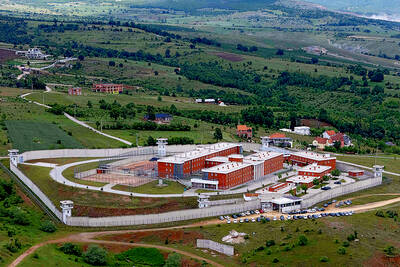Nine people were killed and scores more injured on Sunday when a powerful earthquake measuring close to 6.0 on the Richter scale struck an island off Iran's southern coast, officials said.
Five villages were damaged when the quake hit Qeshm Island at 1:53pm and was felt for more than 10 seconds.
"The toll stands at nine dead and we are not expecting it to increase. Between 70 and 80 people were injured," Qeshm Island governor Heydar Alishbandi said by telephone after touring the affected area.
The Gulf island, home to some 100,000 people, is situated off the coast from the large port city of Bandar Abbas.
"Three helicopters are taking the injured to hospitals in Bandar Abbas and ferries are available if needed. Tents and other relief supplies have been sent to the area," he said.
Another tremor, measuring 5.5 on the Richter scale, hit the same area hours later at 8:41pm, the official Irna agency said, although there were no immediate reports of damage or casualties from the second quake.
Iranian state television put the intensity of the first quake at 5.9 on the Richter scale, the US Geological Survey put the magnitude slightly higher at 6.1 while a seismic observatory in the French city of Strasbourg put it at 5.6.
Alishbandi said five villages suffered damage of between 40 percent and 70 percent, adding that most of the homes "are made of mud bricks so are now unsafe."
The rocky and barren island was hit almost two years after the southeastern city of Bam -- situated 300km to the north -- was destroyed in a quake that killed tens of thousands of people.
Qeshm, located 1,150km southeast of Tehran, has a busy commercial and fishing port and is also a popular weekend sunshine get-away for Iranian tourists.
However the governor said the island's main town, also called Qeshm, was undamaged. The affected villages were identified as Gabardin, Tonban, Karvan, Tourian and Khaldin -- all situated in the less densely populated west of the island.
Iran sits astride several major faults in the earth's crust, and is prone to frequent earthquakes.
In February, a quake measuring 6.4 on the Richter scale hit the southern town of Zarand, killing 612 people and wounding around 1,400.
In December 2003, the southeastern city of Bam was razed by a 6.7 degree quake that left more than 31,000 people dead.
Mehdi Zareh, the head of Iran's Seismic Research Center, said there was no tsunami risk from the latest quake.
"Because the Persian Gulf is not very deep, a tsunami is not expected," he told the student news agency ISNA.
Contacted by telephone, a hotel worker in Qeshm described the quake as "very strong."
"We were panicked. I saw an injured person with blood on their clothes being taken to a local hospital," said the hotel worker, who asked for her name not to be used.
The quake was also felt across the Gulf in the United Arab Emi-rates (UAE) where residents fled high-rise office and apartment buildings.
"Most of the country's regions were affected by an earthquake of medium magnitude, felt particularly by inhabitants in the northern Emirates," Emirati transport ministry official Sheikha Muza al-Muallah was quoted as saying by the official WAM agency.
Oman's Sultan Qabus University observatory said the earthquake's epicenter was in Bandar Abbas itself, he said.
The UAE interior ministry said no damage had so far been reported and Dubai police chief General Dhahi Khalfan sought to reassure residents, calling in a radio interview for people to "get back to work or go home."

By 2027, Denmark would relocate its foreign convicts to a prison in Kosovo under a 200-million-euro (US$228.6 million) agreement that has raised concerns among non-governmental organizations (NGOs) and residents, but which could serve as a model for the rest of the EU. The agreement, reached in 2022 and ratified by Kosovar lawmakers last year, provides for the reception of up to 300 foreign prisoners sentenced in Denmark. They must not have been convicted of terrorism or war crimes, or have a mental condition or terminal disease. Once their sentence is completed in Kosovan, they would be deported to their home country. In

Brazil, the world’s largest Roman Catholic country, saw its Catholic population decline further in 2022, while evangelical Christians and those with no religion continued to rise, census data released on Friday by the Brazilian Institute of Geography and Statistics (IBGE) showed. The census indicated that Brazil had 100.2 million Roman Catholics in 2022, accounting for 56.7 percent of the population, down from 65.1 percent or 105.4 million recorded in the 2010 census. Meanwhile, the share of evangelical Christians rose to 26.9 percent last year, up from 21.6 percent in 2010, adding 12 million followers to reach 47.4 million — the highest figure

A Chinese scientist was arrested while arriving in the US at Detroit airport, the second case in days involving the alleged smuggling of biological material, authorities said on Monday. The scientist is accused of shipping biological material months ago to staff at a laboratory at the University of Michigan. The FBI, in a court filing, described it as material related to certain worms and requires a government permit. “The guidelines for importing biological materials into the US for research purposes are stringent, but clear, and actions like this undermine the legitimate work of other visiting scholars,” said John Nowak, who leads field

LOST CONTACT: The mission carried payloads from Japan, the US and Taiwan’s National Central University, including a deep space radiation probe, ispace said Japanese company ispace said its uncrewed moon lander likely crashed onto the moon’s surface during its lunar touchdown attempt yesterday, marking another failure two years after its unsuccessful inaugural mission. Tokyo-based ispace had hoped to join US firms Intuitive Machines and Firefly Aerospace as companies that have accomplished commercial landings amid a global race for the moon, which includes state-run missions from China and India. A successful mission would have made ispace the first company outside the US to achieve a moon landing. Resilience, ispace’s second lunar lander, could not decelerate fast enough as it approached the moon, and the company has